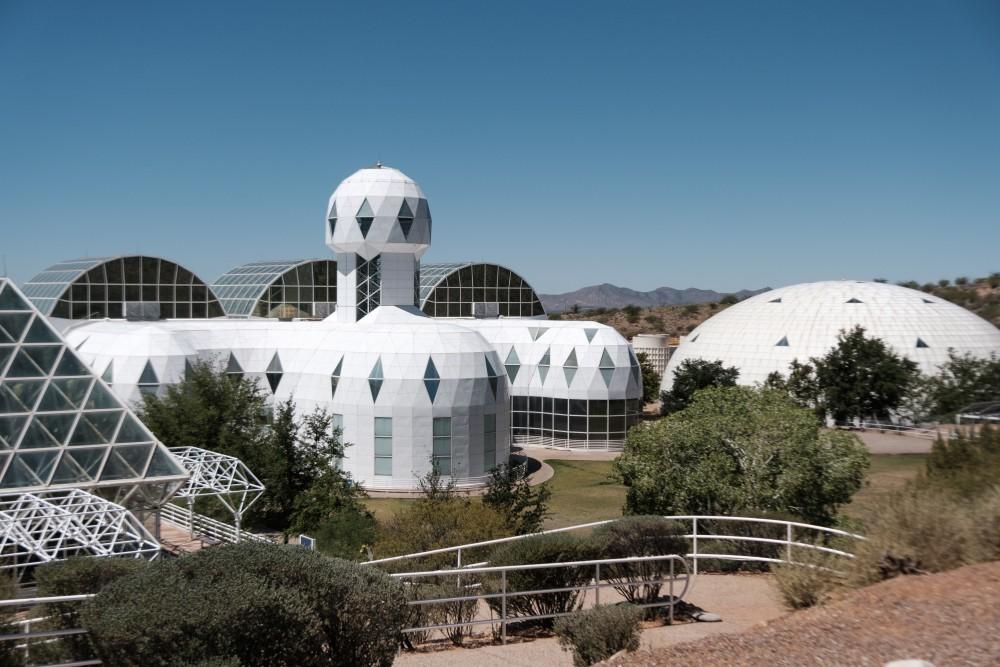Nestled in the foothills of the Catalina Mountains, around 31 miles from Tucson, there exists an oasis; a collection of environments one would never anticipate to exist in the scorched Arizona desert. From a vivid (and often suffocatingly humid) rainforest to a serene and salty ocean, Biosphere 2 is a gateway into a new world.
Biosphere 2 is a one-of-a-kind research facility located five miles southwest of Oracle, Arizona, and is home to five distinct biomes that replicate environmental conditions and further environmental research.
At a time of increased climate urgency, the facility began making strides in climate change research and studied topics ranging from coral reef restoration to agrivoltaics. The biosphere conducts research that can be done “nowhere else in the world,” according to John Adams, deputy director and chief operations officer of Biosphere 2.
Mere minutes and footsteps separate the saturated wetlands, the parched desert and the scenic savanna from each other. The realism of each environment is a testimony to the vast amounts of time and energy scientists at the biosphere put into making these environments feel as realistic as possible. As Adams acknowledged, these biomes are not analogues, but still represent the closest thing to replications of environments on earth.
“They are representative systems similar to those that you might find here on Earth, but, importantly, they’re not analogues. There are no true analogues to Earth,” Adams said. “This allows us at a much larger scale with a more complex system to be able to capture some fundamental processes and then understand the mechanisms that tie soil, plant and atmospheric interactions together.”
Addressing climate change
In the months and years to come, especially as the urgency for climate action increases and the University of Arizona implements its Sustainability & Climate Action Plan, this unique capacity for experimentation at Biosphere 2 will take on an even more significant role in furthering climate change research.
According to Adams, the university understands the capabilities of using a facility like the biosphere to address climate questions.
“The UA saw an opportunity to build and construct the institutional experiment that really, across the disciplines, was addressing a problem that we refer to as these ‘grand challenges’: questions that are not going to be resolved by any single discipline but are going to require a multidisciplinary approach,” Adams said.
The ability to manipulate certain factors in these separate biomes creates an opportunity to study and make sense of environmental conditions that, in many cases, are impossible in the field.
“It allows us at a much larger scale with a more complex system to be able to capture some of those fundamental processes, to then understand the mechanisms that tie soil, plant and atmosphere interactions together, and then to be able to make large-scale manipulations which we’re not able to make when they’re in the field. So, Biosphere 2 is this middle ground, we’re a scaling tool. We’re essentially a facility that allows a much larger magnifying glass on some of these fundamental processes,” Adams said.
The implications of the environmental research done at this facility are felt not just within its glass-domed walls, but in areas across the globe.
For example, in the rainforest biome, the ability to mimic an environment has fueled years of important research; currently, aided by a grant from the Arizona Institute for Resilience, researchers are looking at the effect of temperature on trees in the upper canopy level of the rainforest.
“Biosphere 2 is the hottest rainforest canopy on the planet. The maximum temperature that we have measured in the upper canopy here is about 140 Fahrenheit, or about […] 56 degrees centigrade,” said Joost van Haren, interim director of rainforest research at Bisophere 2. “One of the grad students from ASU, Madeline Moran, has been measuring the critical temperatures for these leaves inside Biosphere 2, and we find temperatures about 8-10 degrees Fahrenheit higher than what people measure in the real world, suggesting that trees can acclimate when they’re exposed to higher temperatures […]. I think still we have this window at being able to recreate conditions that are not happening right now that are happening likely in the next 100-200 years.”
With studies like those being done in the rainforest, researchers at Biosphere 2 are, in some ways, able to predict the future, a skill that is reflected by the facility’s ultramodern building structures pulled straight from the pages of a science fiction novel.
Expanding other areas of research
While it might be challenging for students in Tucson to relate to issues affecting tropical rainforests, van Haren noted that ecosystems like the rainforest and the desert are more closely intertwined than one might initially think. The implications of heat, extreme weather or other climate-related elements on the tropical rainforest can also have a dramatic impact on desert environments like that of Tucson.
“If we would lose the whole Amazon rainforest basin, for instance, like some models have predicted,” van Haren said, there could be “massive cascading effects on climates around the world in different locations.”
Effects could include places changing to become wetter or drier than they are now.
“There are very strong linkages between climate and, again, because the Amazon Basin is such a large area it can really have a disproportionate effect on the global climate,” he said.
The rainforest also offers vast potential for resources in the field of medicine.
“If you’re interested in medicine and so forth, for instance, certain cancer medicines, the only real effective medication that we have for malaria comes out of tropical forests from tropical trees,” van Haren said. “The chemistry of tropical trees is actually still a relatively untapped resource for us, that could help us with all kinds of medications down the road. So if you’re medically inclined, tropical forests should be of interest as well to you in that regard.”
Inspiring the next generation
This capacity for environmental replication at the biosphere has the power not just to harness new scientific discoveries, but also to inspire the next generation of climate scientists, according to Hunter Gibbs, a UA student and director of Project Rethink Climate, who facilitates field trips to Biosphere 2 for students.
“What the biosphere shows is that we have such a deep understanding of climate and ecosystems that we can literally replicate ourselves what took 4 1/2 billion years to make,” Gibbs said. “And if we could do that, and we put our minds together and we are convicted in our passion for the environment, then we can do anything, we can overcome what seems impossible to overcome.”
Through Project Rethink Climate, Gibbs was able to provide a tangible measure of the impact the facility had on student outlook as it pertained to climate change, offering a survey that asked about their climate optimism before and after their trip to Biosphere 2.
“Students’ optimism for the outlook on climate on a scale of 1 to 10 was about 4.7. And even after the tour, on average that went up to about 6.2. So seeing that jump of 1.5 points, just from that tour, is a testament to the potential we can have on these students getting increasingly confident in their beliefs and increasingly confident that they can have a change and make a change just off of one afternoon,” Gibbs said.
Research beyond planet Earth
While this climate research is an especially prevalent point of public discourse, Biosphere 2 does more than just look at Earth’s environment and climate effects: it goes above and beyond (literally), furthering the field of human spaceflight research.
The Space Analog for the Moon and Mars is a flashback to the origin of the Biosphere 2 facility: built around the 1987 Biosphere 2 Test Module, SAM is a unique, hermetically sealed environment that offers the closest thing a person can get to living on Mars.
“SAM basically took what was the prototype before they built Biosphere 2, they refer to it as a test module, and they’ve gone through and renovated that facility, brought it back into sort of a workable state because it hadn’t been used for some period of time,” Adams said. “And now what they’ve created is a hermetically sealed environment, an airtight environment where you can run simulations and test ideas, concepts, instrumentation and tools that could potentially be used in space first here before you attempt to take them into space.”
Visiting research teams are able to propose projects to conduct in SAM. These projects can range in fields from “biology, plant physiology, regolith chemistry and soil ecology, food cultivation, AI and robotics, personal psychology, tool use, haptics, and habitation studies to name a few,” according to Biosphere 2.
The UA has long been a leader in space research, and the recent Space Act Agreement between the UA and NASA will provide more opportunities for the university to engage in space flight research. The Space Analog for the Moon and Mars is a prime target for future collaborations in this field. Led by Kai Staats, research director for SAM, the analog offers the potential to train astronauts headed to the moon or Mars.
“Now there’s continued discussions about what it’s going to take to get back into space. And how do we have humans in space? How do we become an interplanetary species? And so this, I think, is very complementary to what the university is going to be pushing for because we’re going to see greater emphasis and greater research opportunities in this arena,” Adams said. “And so this is a tool that we have that very few other institutions have that will allow us to uniquely address questions that will hopefully allow us to become an interplanetary species and allow the University of Arizona to be, you know, set as a leader in this research arena.”
For more information on Biosphere 2, including visiting hours and how to buy tickets, go to biosphere2.org. The website also has multiple sections dedicated to research done at and plans for Biosphere 2.
“It’s a really unique opportunity to work in the world’s largest controlled environment that is dedicated to understanding the resiliency of ecosystems under the future threat of climate change,” Adams said.
Follow the Daily Wildcat on Instagram and Twitter (X)










